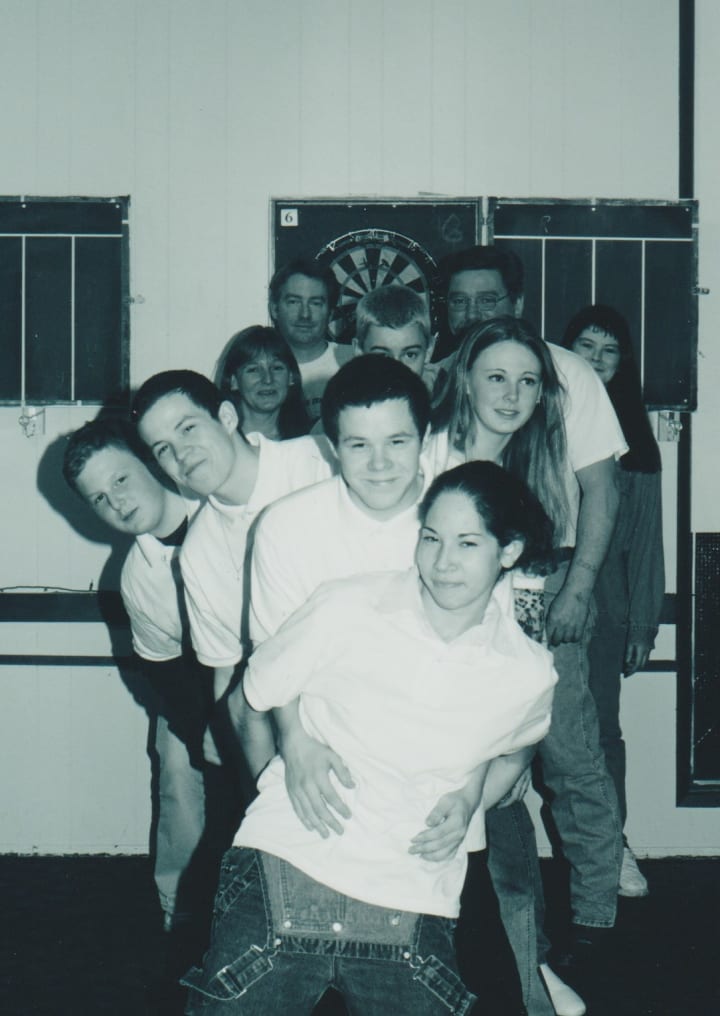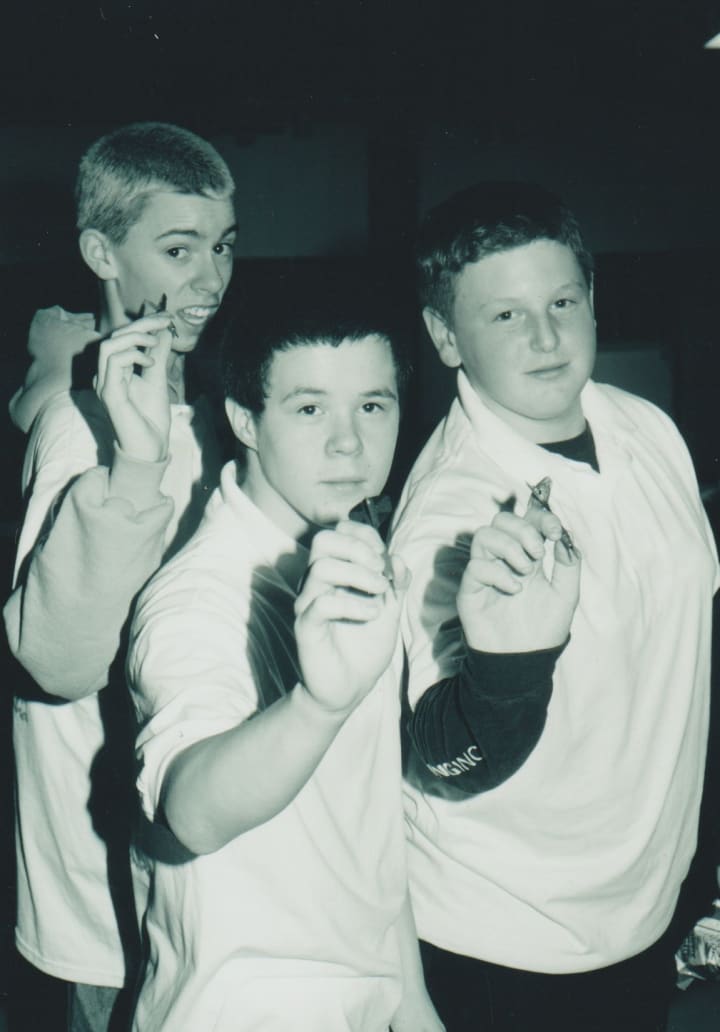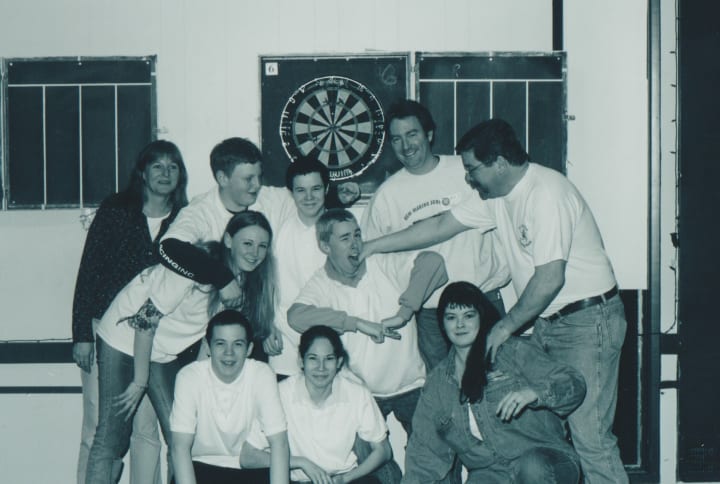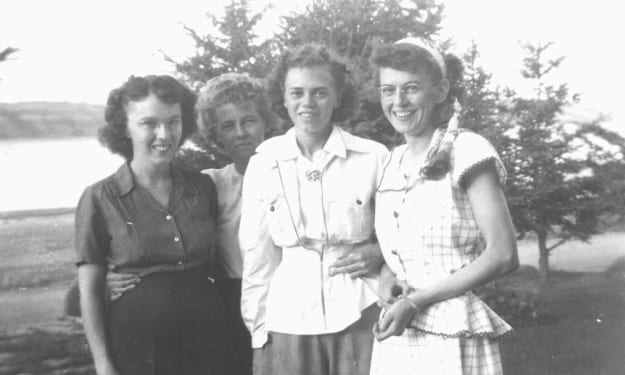Getting to the Point
An introduction to the world of competitive darts for the teenage crowd.

As a father of teenage children who seem to be involved only in video games, marathon telephone calls, television and hanging out in the mall, it is refreshing to find that my son and daughter have become interested in the game of darts. That’s right, darts – the game that I once played with red and blue plastic-winged projectiles in pubs on Saturday nights. I have always imagined this as a past time reserved for big-bellied British sheep farmers and aging war veterans. However, the local Legion Hall has, on Sundays, become the venue for several of the local youth in our community to get together and compete in an afternoon of darts. Teenagers clad in non-traditional darts garb complete with low hanging, baggy blue jeans, backward baseball caps and long untucked sweaters and shirts have become uncharacteristically focused in their attempts to succeed at this centuries-old game. Occasionally, a mini-van full of school-aged children from a neighboring center will unload at the hall and the afternoon becomes flavored with town-to-town rivalry as the missiles take flight at those modern-day log-ends.

History of the Game
It is commonly agreed that the game of darts originated in the Middle Ages on the battlefields of France. Warriors would toss broken arrows and javelots (short spears used in battle) at the flat-end surfaces of logs in recreational contests between battles. The logs were not portable so cookies were cut from the ends and these log-ends were used to move the game indoors during winter and other times of serious weather conditions. The log-ends tended to crack radially as they dried and thus the board was naturally partitioned into desirable and undesirable target areas. The annual rings on the log-end served to further divide the board into point zones. During more peaceful times, the playing board was fashioned out of the butts of wine casks or beer kegs and since breweries seemed to have a monopoly on these articles, the game soon came to be associated with pubs and beer parlors. The standardization of the rules actually came about as a result of keg and crate sizes. As the dimensions of the liquor containers changed so did the standards for the game. Much of the jargon and slang that is a part of the game today was born of the equipment used in those early days. For example, the dartboard itself is still often referred to as a log-end and the throwing line is known as the hockey, which came from the name of the brewing company whose crates were used to measure the distance from thrower to board. Later, concentric circles were drawn or carved onto the cask butts to simulate the annual rings that once appeared on the log-ends of the game’s first players. In 1530, Anne Boleyn gave Henry VIII a set of “richly ornamented” darts and in 1620, the Pilgrim fathers are known to have played darts aboard the Mayflower as it traveled to America from the old world.
Equipment
Unlike traditional teenager activities (like driving, dirt biking, minor hockey, shopping, partying, music and computers) darts is relatively inexpensive. Depending whether a player buys new or used equipment, one can start play for less than $20 or more than $200. The choice is theirs (or their parents).
When my children started to play the game I was surprised at the variety of equipment there was available. First of all, the darts themselves are made of at least four different components – the tip (steel or soft), the barrel (fat, slim, light, heavy, brass or tungsten), the shaft or stem (short, long, blue, red, flat or metallic) and the flight (conservative or wild and crazy). Add-ons to protect the flights or sharpen the tips or weight the barrels provide even more to the complexity of the equipment and the decisions to be made while purchasing. All of these parts are movable and interchangeable so a player can customize a set of darts to his or her liking in the beginning and at any point throughout his or her dart-playing future. As a result, the three darts that are finally stored in the mandatory carrying case (which can be made of plastic or leather and which can have room for one set of three barrels and shafts or several sets and separate space for three or six flights) can cost a little or a lot. Long time players of the game that I have met on my Sunday afternoon visits to the Legion Hall invariably recommend that a player spend as much money on equipment as can be afforded without going for only the most expensive of items. As well as an increase in “feel” and early success there is an attitude of pride that goes with good equipment and supposedly this frame of mind carries over into the way a thrower plays the game. It makes sense I guess. I’m sure I will be able to figure all of that out once I become a more experienced darts’ parent.

Nevertheless, I found that each player should start with three darts weighing somewhere between 18 and 25 grams. Three functional flights should also be purchased along with a carrying case in which to store everything. A case is a good idea because the parts are small and delicate and therefore, easily lost or damaged in the aftermath of teenage bedroom storms. It is important that the player using the darts try them before buying. They should feel right and they should fly in a true enough manner that they do not flutter noticeably in their flight distance. Darts can be purchased at hardware stores and department stores but a player should avoid purchasing equipment at outlets that do not make provisions for trial of the equipment. Retail outlets for darts should also have a scale or balance to weigh the darts before a sale is final. One should not purchase a set of darts in which the weight of any of the three darts varies by more than 2/10 gram from any other dart in the set.
I also managed to pick up a used bristle board dartboard from the Legion for five dollars. We have mounted the board at the correct height on a movable plank so the kids can practice at home in any one of several locations. I have also seen good inexpensive bristle board dartboards at garage sales and flea markets. It is important not to buy the thin paper dartboards available in department stores. Good darts will destroy poor boards in very short order. Good darts will also penetrate thin paper boards completely thus damaging walls behind the board while dulling the dart tips in the process. It has been made clear to me to look for the bristle board material, which is a very dense velvety type of board. These boards will last a long time and protect the darts under normal use.
A final appealing feature of the game of darts for parents is that it is played at sensible times of the day and in the most forgiving of environments. Unlike minor baseball, soccer and hockey there are no 6:00 a.m. practices in cold rinks or games played outdoors during sandstorms, record-setting heat waves or torrential downpours. Instead, parents can enjoy the pleasures of comfortable seating, restaurant menus and ample beverage choices while watching their children play the game.
Rules
Once equipment has been purchased, ‘players’ will want to ‘play’. If there is no permanent spot for the board to be situated it is a good idea to mount the dartboard on a moveable backboard so that the center of the dartboard is 5’8” from the floor edge of the backboard ensuring the dartboard is always at the correct height from the floor when the assembly is standing. If the players happen to have a four Hockey & Sons Brewery cases from 18th Century England, they can be placed end to end to determine the correct placement of the toe line. If not, they can measure a span of 7’9 ¼ “ from the base of the upright backboard and place a toe line at that distance.
A variety of dart games exist. All of the games are played with the dartboard set at the prescribed height and distance. All of the games require excellent hand-eye coordination and a fine throwing technique. All of the games insist that the players are able to quickly perform all four basic mathematics operations with numbers from zero to 501. Finally, all of the games are fun and competitive and can be played individually or as part of a team of two or more players.
a) Standard Play
Starting at a score of 501 or 301, players throw three darts in a turn, subtracting the total from their previous score. The first player or team to reach zero wins.
b) Hound and Hare
A player or team designated as the Hare attempts to place a dart in each number on the board starting at the 20 and working clockwise while throwing three darts in a turn. The player or team designated as the Hound attempts to do the same while returning to the 20 again before the Hare does so.
c) Round the Clock
Each player, throwing three darts in a turn attempts to place a dart in each number before the opponent. Variations of this game include playing the numbers in order or in backward order or simply randomly.
d) Baseball
Each player, throwing three darts in an inning attempts to score as many points as possible. In the first inning only ones will score points and in the second inning only twos will score points and so on. After nine turns or innings by each player, the player with the highest score wins.
Other games include Wimbledon, Shanghai, Flat Earth and Cricket. The point being that there are dozens of dart games with documented rules and dozens more that can be created by players at the time they decide to play.
Opportunities
There was a time not so long ago that my children spent weekend days moping around the house complaining about being bored and trying to avoid doing homework. I might have found them simply talking on the telephone with their friends while making plans for parties and other activities that tend to make parents go gray or age before their time. Some teenagers get into minor sports or hiking or other outdoor pursuits and so their parents never have to worry about where they are and what they are doing. However, these activities don’t suit all teenagers and for the ones that don’t manage to play them, free time becomes an enemy and bad habits emerge and trouble starts to happen. Darts has proved a blessing for my kids and I both. I know where they are now. I know whom they are with and what they are doing for at least part of the time they are away from home. They don’t even mind that I follow along to watch them play. They don’t mind that they have to become proficient at math to keep up with their opponents and I actually feel relieved about the fact that they spend part of the weekend in the pub (which has been transformed into a games venue). They carry on conversations with their friends and new acquaintances that consist of more than monosyllabic grunts. Most importantly though, they have a focus and a sense of purpose that is fun for them – a focus that I don’t have to beat them to keep. They are willing to do that on their own. There are far worse things they could be doing with their time and far worse things on which they could be spending their money.
I am appreciative of the efforts made by several of the parents and a handful of community members to secure a venue and playing time for the boys and girls to play. The Legion Hall pub has been booked as the site for practice, play and several tournaments. It is an obvious practical choice because of the availability of equipment already set at official distances and heights. The pub venue is also a great historical choice because our young players are now casting darts in the same environment as some of the very first throwers. The Legion also has affiliation with the provincial and national Darts Associations thus affording opportunity for the players to advance in play if they desire. Sunday afternoons have been set aside for the junior players as this time interferes least with other Legion meetings and activities. With this infrastructure in place all that remains is for the players to get up on time and get down to the hall.

A relatively small investment of time and money can provide a 14-year old with the opportunity to socialize, practice hand-eye coordination and perform mental mathematics operations in an enjoyably safe and socially acceptable environment. Expanded vocabularies that once included only computer-related terms like boot, burn, download and cheat codes now contain doubling in, toe lines, bulls and Robin Hooding. Parents will not only place their stamp of approval on the activity but will deliberately set aside time to help shop for equipment, drive to weekly competitions and tournaments and yes - even take their children to the pub on Sunday afternoons. It has become a convenient way for teenagers to mix with others their age for the purpose of socializing and practicing dartsese. Finally, it is an avenue for parents to acquaint themselves with their children and each other. It is beneficial for the soul to know about and be involved in the activities of one’s children. For parents, that is truly getting to the point.
About the Creator
John Oliver Smith
Baby, son, brother, child, student, collector, farmer, photographer, player, uncle, coach, husband, student, writer, teacher, father, science guy, fan, coach, grandfather, comedian, traveler, chef, story-teller, driver, regular guy!!
Enjoyed the story? Support the Creator.
Subscribe for free to receive all their stories in your feed. You could also pledge your support or give them a one-off tip, letting them know you appreciate their work.






Comments
There are no comments for this story
Be the first to respond and start the conversation.